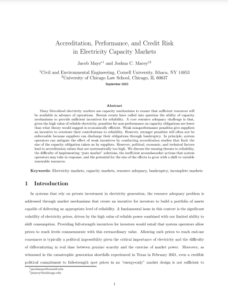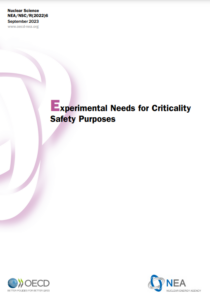The OurEnergyLibrary aggregates and indexes publicly available fact sheets, journal articles, reports, studies, and other publications on U.S. energy topics. It is updated every week to include the most recent energy resources from academia, government, industry, non-profits, think tanks, and trade associations. Suggest a resource by emailing us at info@ourenergypolicy.org.
Resource Library
The productive use of electricity in rural communities can contribute to significant socioeconomic development and increased welfare. The virtuous cycle of productive use of electricity assumes that early development creates higher incomes, leading to increased demand for electricity and further investment in improving electricity quality and availability. Electricity suppliers benefit from higher revenue and financial sustainability, and appliance dealers, credit services, and investors benefit from market growth. This report highlights the importance of actively promoting productive uses to micro, small, and medium-size enterprises (MSMEs), including small farmers, as a way of accelerating development after communities gain access to electricity.
The …
View Full ResourceMany liberalized electricity markets use capacity mechanisms to ensure that sufficient resources will be available in advance of operations. Recent events have called into question the ability of capacity mechanisms to provide sufficient incentives for reliability. A core resource adequacy challenge is that, given the high value of reliable electricity, penalties for non-performance on capacity obligations are lower than what theory would suggest is economically efficient. Weak non-performance penalties give suppliers an incentive to overstate their contributions to reliability. However, stronger penalties will often not be enforceable because suppliers can discharge their obligations through bankruptcy. In principle, system operators can …
View Full ResourceRapid growth of distributed photovoltaics (DPV) has upended how engineers traditionally think about electric power systems. Consumers now increasingly generate their own power and feed it to the grid. Poorly managed DPV poses distinct risks for power systems as penetration increases. Yet, low- and middle-income countries can benefit from this clean distributed energy resource. How can DPV and power systems be planned and operated to mitigate risks and reap technical benefits? This report presents a menu of DPV technical solutions applicable across diverse contexts.
Balancing DPV supply with local loads, as far as practical, can help keep grid operations within …
View Full ResourceThe Task Force on Dose Rate Calculations for Irradiated Fuel Assembly was launched in 2015 to assess code predictions of dose rates from bare spent fuel assemblies and to benchmark multiple codes and validate them against available experimental data. This report provides details of the benchmark specifications, method and code characteristics, as well as a comparison and analysis of the calculation results.
The dose rate from a spent fuel assembly (FA) is an important attribute for two reasons. The first is to determine shielding and handling requirements to protect personnel working with spent fuel, while the second is related to …
View Full ResourceThis Carbon Removal Market Insights Report presents the state of the carbon removal market and opportunities for business leaders to advance climate action. The report is specifically geared to corporate leaders who are looking to incorporate carbon removal into their climate action plans. It highlights both the challenges and opportunities to be frontrunners in a growing effort to reverse the impacts of climate change. The report provides an industry-related snapshot in 2023, and of where the industry is heading in years to come. It concludes with recommendations for accelerating business leadership in carbon removal.…
View Full ResourceIndividual demand for emerging technologies can be influenced by the demand of other individuals within defined peer groups. These so-called peer effects have been demonstrated in emerging clean energy technologies such as rooftop solar. To date, peer effects have disproportionately driven solar adoption among relatively affluent households. The report uses household-level income estimates of rooftop solar adopters to explore how peer effects drive adoption for low-income households. They find evidence of peer effects for both high- and low-income households and find that peer effects are generally stronger within than across income groups. The results indicate that peer effects translate to …
View Full ResourceThe goal of the Nuclear Energy Agency (NEA) Working Party on Nuclear Criticality Safety (WPNCS) Subgroup on Experimental Needs for Criticality Safety Purposes (SG-5) was to highlight the needs of integral experiments and to identify the available experimental facilities where integral experiments could be performed. Subcritical, critical and supercritical experiments were considered as they contribute to code and nuclear data validation and criticality accident study. Such experiments also play a role in the bias and uncertainty estimation for safety issues.…
View Full ResourceTo address the myriad challenges posed by global climate change, countries at all income levels have put in place a diverse set of policies over the past three decades. Many governments have already made significant progress in their efforts to decarbonize, creating a rich history of implementation experiences that provides important lessons for how to successfully advance climate policy goals in a variety of different economic, cultural, and political contexts. Despite this progress, the transition to a net zero future continues to face significant barriers, including the need for large investment, a lack of institutional capacity, and challenging political economy …
View Full ResourceIn 2021-2022, Baltimore Gas & Electric (BGE) and Pepco Holdings Inc. (PHI) collaborated with the Smart Electric Power Alliance (SEPA) on a project focused on enhancing grid investment decisions with an emphasis on resilience and equity. The project aimed to identify grant opportunities and explore unconventional distribution upgrades. BGE and PHI were also engaged in efforts to strengthen grid infrastructure and implement innovative clean energy solutions to meet sustainability and resilience objectives at the state and utility levels in Maryland.…
View Full ResourceIn 2019, the Department of Energy’s Geothermal Technologies Office with support from the National Renewable Energy Laboratory (NREL) released the GeoVision report and associated Non-Technical Barriers Task Force report. The Non-Technical Barriers Task Force report identified states in the eastern and southern United States that do not have geothermal regulations for power production or direct-use applications. In addition, other discussions have indicated interest from other states in updating existing geothermal regulations that have been in place for decades. Based on these findings, the intent of this document is to provide information that states might find valuable when developing geothermal regulations …
View Full Resource








